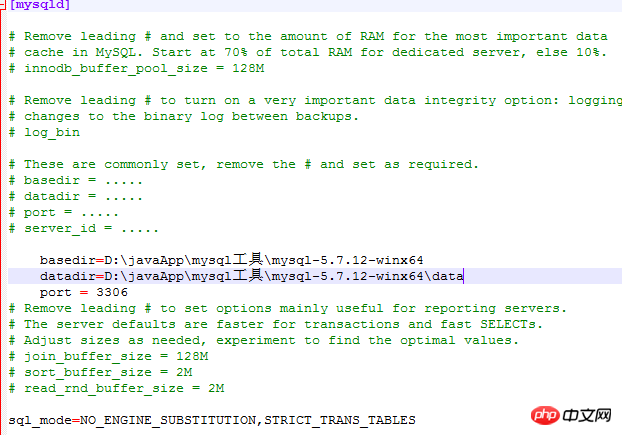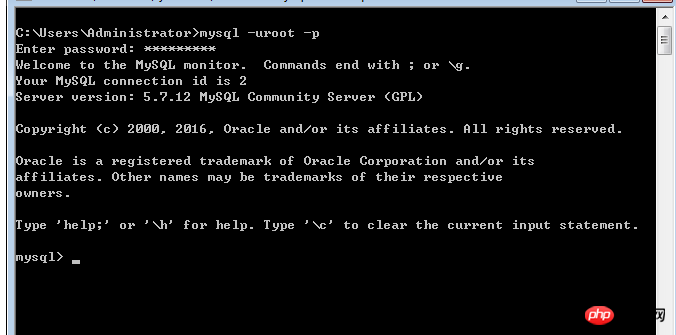 Database
Database
 Mysql Tutorial
Mysql Tutorial
 Mysql 5.7.12 win64 manual installation tutorial steps (pictures and texts)
Mysql 5.7.12 win64 manual installation tutorial steps (pictures and texts)
Mysql 5.7.12 win64 manual installation tutorial steps (pictures and texts)
This article mainly introduces the graphic tutorial of mysql 5.7.12 winx64 manual installation and configuration method in detail. Interested friends can refer to it
If you want to install it, of course you must first have a MySql installation package here The one used is mysql-5.7.12-winx64
1. Unzip the compressed package to your designated location (it is best to classify the tool files you want to use OK)
For example: D:\javaApp\mysql-5.7.12-winx64
2. Configure environment variables
Enter the corresponding storage directory , Copy the directory path
For example: D:\mysql-5.7.10-winx64\bin ,
Configure environment variables (user environment variables can also be configured, system environment variables can also be configured)
Append after PATH ;D:\mysql-5.7.10-winx64\bin; (note the English semicolon)
3. Enter the file you decompressed, there will be a my in the directory -default.ini File Right-click the file and open it with Notepad
MySQL will read this file when it startsmy-default.ini
We need to write some configurations in this file
basedir=D:\javaApp\mysql-5.7.12-winx64
datadir=D:\javaApp\mysql -5.7.12-winx64\data
port = 3306
basedir: is the installation location of our decompressed file
datadir: Also add \data to the decompression location and OK
port: is the port number of MySql
is as follows:

4. Click Start ---->All Programs---->Accessories---->Command Prompt (right-click to run as administrator) cd to enter the installation directory of MySql just now
---->All Programs---->Accessories---->Command Prompt (right-click to run as administrator) cd to enter the installation directory of MySql just now
For example: cd D:\javaApp\mysql-5.7.12-winx64\bin; In d: switch the drive letter
as shown:

Enter mysqld --install in this path (this is to add the MySql service)
Successful installation will output: Service successfully installed.
As shown in the figure:

5. Initialize MySQL
Continue to enter in the command prompt: mysqld --initialize --console
This is Initialize the database, and then you can see a root@localhost at the end of the initialization:
followed by a series of alphanumeric symbols, which is a random password generated by MySQL. Write it down,
as shown in the figure :

When we log in to the MySQL database later, we will use.
6. Windows+R key, Run: services.msc
Find the corresponding Mysql service and start it
7. Modify the MySQL default password
After starting, we Log in to the MySQL database and enter the command
Mysql -uroot -p
Press Enter and you will be asked to enter a password. At this time, enter the password randomly generated by MySQL just now and press Enter to log in.
Log in After entering, directly enter:
SET PASSWORD = PASSWORD ('your new password'); change the password.
After changing the password, you need to restart the MySQL service to take effect
8. Restart the service because After configuring the environment variables, we can directly enter mysql -uroot -p. This step requires entering the database password, which is the password we just changed.
The picture after success is as follows:

The above are mostly written about the installation steps, but they are just a few clicks of the mouse to copy.
Related recommendations:
How to download the latest MySQL installation package from the official website?
CentOS 6.5 Detailed steps to install MySQL 5.7.12 (pictures and text)
mysql-5.7.12 decompressed version installation step tutorial
The above is the detailed content of Mysql 5.7.12 win64 manual installation tutorial steps (pictures and texts). For more information, please follow other related articles on the PHP Chinese website!

Hot AI Tools

Undresser.AI Undress
AI-powered app for creating realistic nude photos

AI Clothes Remover
Online AI tool for removing clothes from photos.

Undress AI Tool
Undress images for free

Clothoff.io
AI clothes remover

AI Hentai Generator
Generate AI Hentai for free.

Hot Article

Hot Tools

Notepad++7.3.1
Easy-to-use and free code editor

SublimeText3 Chinese version
Chinese version, very easy to use

Zend Studio 13.0.1
Powerful PHP integrated development environment

Dreamweaver CS6
Visual web development tools

SublimeText3 Mac version
God-level code editing software (SublimeText3)

Hot Topics
 Reduce the use of MySQL memory in Docker
Mar 04, 2025 pm 03:52 PM
Reduce the use of MySQL memory in Docker
Mar 04, 2025 pm 03:52 PM
This article explores optimizing MySQL memory usage in Docker. It discusses monitoring techniques (Docker stats, Performance Schema, external tools) and configuration strategies. These include Docker memory limits, swapping, and cgroups, alongside
 How to solve the problem of mysql cannot open shared library
Mar 04, 2025 pm 04:01 PM
How to solve the problem of mysql cannot open shared library
Mar 04, 2025 pm 04:01 PM
This article addresses MySQL's "unable to open shared library" error. The issue stems from MySQL's inability to locate necessary shared libraries (.so/.dll files). Solutions involve verifying library installation via the system's package m
 How do you alter a table in MySQL using the ALTER TABLE statement?
Mar 19, 2025 pm 03:51 PM
How do you alter a table in MySQL using the ALTER TABLE statement?
Mar 19, 2025 pm 03:51 PM
The article discusses using MySQL's ALTER TABLE statement to modify tables, including adding/dropping columns, renaming tables/columns, and changing column data types.
 Run MySQl in Linux (with/without podman container with phpmyadmin)
Mar 04, 2025 pm 03:54 PM
Run MySQl in Linux (with/without podman container with phpmyadmin)
Mar 04, 2025 pm 03:54 PM
This article compares installing MySQL on Linux directly versus using Podman containers, with/without phpMyAdmin. It details installation steps for each method, emphasizing Podman's advantages in isolation, portability, and reproducibility, but also
 What is SQLite? Comprehensive overview
Mar 04, 2025 pm 03:55 PM
What is SQLite? Comprehensive overview
Mar 04, 2025 pm 03:55 PM
This article provides a comprehensive overview of SQLite, a self-contained, serverless relational database. It details SQLite's advantages (simplicity, portability, ease of use) and disadvantages (concurrency limitations, scalability challenges). C
 Running multiple MySQL versions on MacOS: A step-by-step guide
Mar 04, 2025 pm 03:49 PM
Running multiple MySQL versions on MacOS: A step-by-step guide
Mar 04, 2025 pm 03:49 PM
This guide demonstrates installing and managing multiple MySQL versions on macOS using Homebrew. It emphasizes using Homebrew to isolate installations, preventing conflicts. The article details installation, starting/stopping services, and best pra
 How do I configure SSL/TLS encryption for MySQL connections?
Mar 18, 2025 pm 12:01 PM
How do I configure SSL/TLS encryption for MySQL connections?
Mar 18, 2025 pm 12:01 PM
Article discusses configuring SSL/TLS encryption for MySQL, including certificate generation and verification. Main issue is using self-signed certificates' security implications.[Character count: 159]
 What are some popular MySQL GUI tools (e.g., MySQL Workbench, phpMyAdmin)?
Mar 21, 2025 pm 06:28 PM
What are some popular MySQL GUI tools (e.g., MySQL Workbench, phpMyAdmin)?
Mar 21, 2025 pm 06:28 PM
Article discusses popular MySQL GUI tools like MySQL Workbench and phpMyAdmin, comparing their features and suitability for beginners and advanced users.[159 characters]





